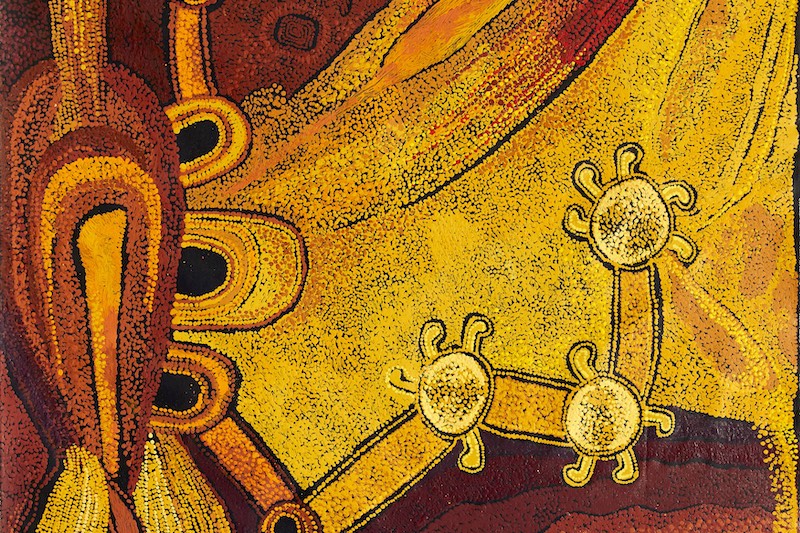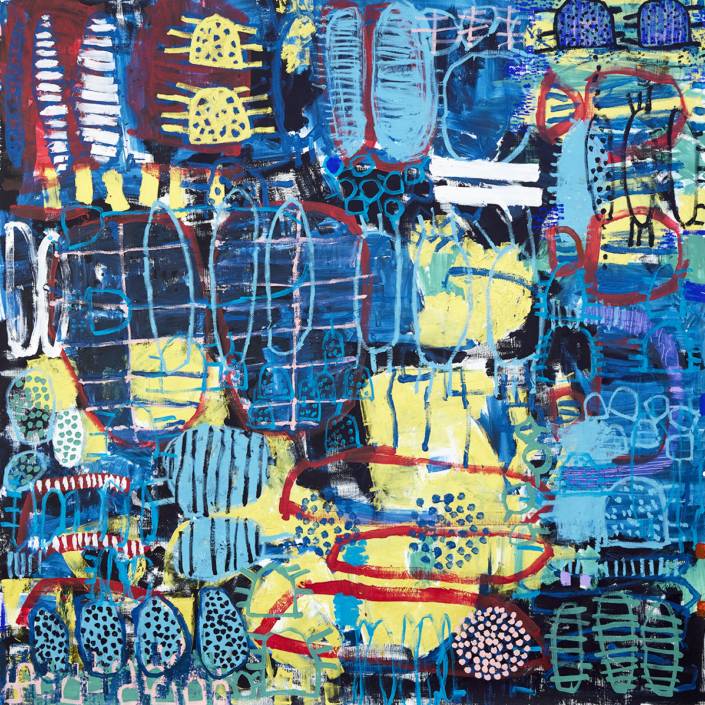Teresa Baker: A Practice Shaped By Spirits
Teresa Baker’s paintings express an elaborate relationship to Country, with female perspectives and songlines.
Words: Louise Martin-Chew
Photography: Simon Anderson Photography
There is intensity in the painting of Teresa Baker, a visceral appearance which draws the eye in and around red and orange shapes, contained and extended by dotted lines of nuanced yellow, threads and lines connecting to each other, offering depth, visual nourishment and a sense of a large narrative within a broad landscape. She lives in Kanpi, the small outstation to which her family moved, within the APY Lands, to be closer to their Country. It is in a remote part of South Australia, about 20 kilometres south of the border with the Northern Territory, and sits at the base of the Mann Ranges. Her paintings are focussed on the journey of her pre-eminent female spirit ancestor, Malilu, who is known for strength and independence. Baker’s Wynne Prize entry, Minyma Malilunya, 2017 depicted the dance of the crippled Malilu, deserted by her daughters, and her ability to, nonetheless, gather the bush foods and water she needed, albeit with the painful dragging of her leg as she travelled across the landscape.
Teresa Baker is from an artistic family. As a child she lived in Kanpi with her grandfather, artist Jimmy Baker, and her grandmother. She remembers him taking her out to the rock holes as a 12-year-old girl where he told her the stories at important sites. Later she lived with her mother, Kay Baker, also an artist, in Fregon. She moved back to Kanpi after finishing school, and in 2005 began painting at the Tjungu Palya art centre. “I used to sit next to Jimmy Baker, he was a good friend, and watch what he did. He showed me painting stories about emu and his Country.” In the last decade Baker has made significant gains, having been a finalist in the Telstra Awards in 2013 and 2016, and the 2017 Wynne Prize. This year she has focussed on completing work for her solo exhibition at Vivien Anderson Gallery.
Malilu was known for managing epic conflicts between the forces of nature, the environment and human behaviour. The artist said, “When I paint, in my heart I’m feeling it. Maybe that spirit’s there, maybe Malilu is teaching me. I love that Country. When I was a little girl I just felt the pull, the feeling that I had to go there. I feel ‘wiru’ (beautiful) inside that Country.”
Baker is not a prolific artist, and is also in demand with her community relying on her for assistance with governance issues. She works with her daughters and other girls for whom she cares, showing them what is possible with paint at the Tjungu Palya Art Centre. Manager Liz Bird said, “Teresa’s style has evolved over the years. The earlier work emulated the way Jimmy Baker would put down his dots with high contrast, but she has shifted into more tonal gradients. Of all of our artists, Teresa has a particular sensibility for working with colour. The new body of work is a very confident example of her ability with colour and composition. She starts anywhere on the canvas and puts detail around what she has put down at the start and shifts across the canvas in a very beautiful way.”
Vivien Anderson has been exhibiting Baker since 2013, with this exhibition her second solo. Anderson said, “Some of her earlier work presented mechanised imagery like plumbing apparatus, alluding to force under pressure, which is part of her narrative. Her heroine is the Emu Woman, from the narrative Malilunya, who shape-shifts into water and thunders through the subterranean cave system underneath her Country to avoid capture by tricky men. Her compositions are so dynamic, she explores power through paint and movement.”
Last year, Baker was selected for the Australian Centre for Contemporary Art’s Painting. More Painting, a survey of contemporary Australian work, which included artists such as Angela Brennan, Matthys Gerber, Stephen Bram and Vivienne Binns. Baker’s work was hung opposite that of Karl Wiebke, with three works each. Anderson said, “It was one of the most beautiful spaces, and Teresa was very pleased and proud to see her work there”. Co-curator of the exhibition, Hannah Mathews said, “Her work has a distinct position and approach to landscape that is shaped by her experience and culture as an Indigenous woman. Sometimes made with other women in her family, Baker’s paintings express an elaborate relationship to Country, with female perspectives and songlines. Her landscapes are sometimes shaped by spirits and other times by machines. The dynamism captured in her works is compelling.” For Mathews, Baker’s palette and composition are also very powerful. “You can get lost in the paint; her works are vibrant and rich, they generously welcome you into the stories of her Country”.
HANNAH MATHEWS, Senior Curator, Monash University Museum of Art (MUMA), Melbourne
“I had the pleasure of encountering Teresa Baker’s work for the first time last year through my role as Senior Curator at Monash University Museum of Art (MUMA). One of her paintings had entered the Monash Collection and I was absolutely taken with the power of its palette and composition. There was something so en- ergetic and affirming about it. It’s a quality I see in many of her works. Baker’s paintings hold a sense of resolution, determination and admiration for the land and its stories. The work is also powerfully female.” Mathews in- cluded Teresa in the solo projects Painting. More Painting at the Australian Centre for Contem- porary Art (ACCA) and witnessed “one couple returning again and again to stand in front of Baker’s paintings over several hours. They were held by the painting’s energy and its ability to vibrate through her choice of tonal range and dot and line work.” According to the curator, Baker is of critical importance as her painting’s “depict a relationship to land that is informed not only by her culture but by her position as an Indigenous woman. She captures the land in its beauty but also in its transformation through dreaming stories (Malilu) and interac- tions with the man-made. Her paintings seem to hold the past and future in both hands and I think this quality sets her work apart from much landscape painting, Indigenous and non- Indigenous.” – Emma O’Neill
VIVIEN ANDERSON, Director, VIVIEN ANDERSON GALLERY, Melbourne
“In 2011, I exhibited Teresa Baker as part of a larger group exhibition of Tjungu Palya women artists. It was apparent then that her compositions were constructed quite differently from the other artists, who chose freer use of colour and application of paint. Teresa works within a one or two colour range, she engineers her composition to show the key elements of the narrative.” says Vivien Anderson, director of the eponymous Melbourne gallery. Anderson was surprised by “how confident first time collectors were at her last solo exhibition in 2015.” That said her supporters are equally split between “experienced private and institutional collectors who recognise the originality in Teresa’s work and newbies, taking their first leap of faith.” The forthcoming solo show at Anderson’s gallery will be priced from $5,000 – $25,000. The exhibition is much anticipated given the artists award as a finalist in this year’s Wynne Prize at the Art Gallery of New South Wales and her participation in Painting More Painting in 2016 at the Australian Centre for Contemporary Art (ACCA), which “pretty much cemented the respect she has from mainstream curators.” While Baker’s work is already highly coveted, Anderson believes the artist will continue on a steady trajectory, “At this stage, her output is enough to assure her participation in major art prizes and selected commissioned exhibitions and a solo every two years. Her own self-realisation as an artist is solid, she feels no pressure, she is sure of her own accomplishments.” – Emma O’Neill
Teresa Baker shows at Vivien Anderson Gallery, Melbourne in association with Tjungu Palya, South Australia from 15 November – 9 December, 2017.
This article was originally published in Art Collector issue 82, OCT-DEC, 2017.









